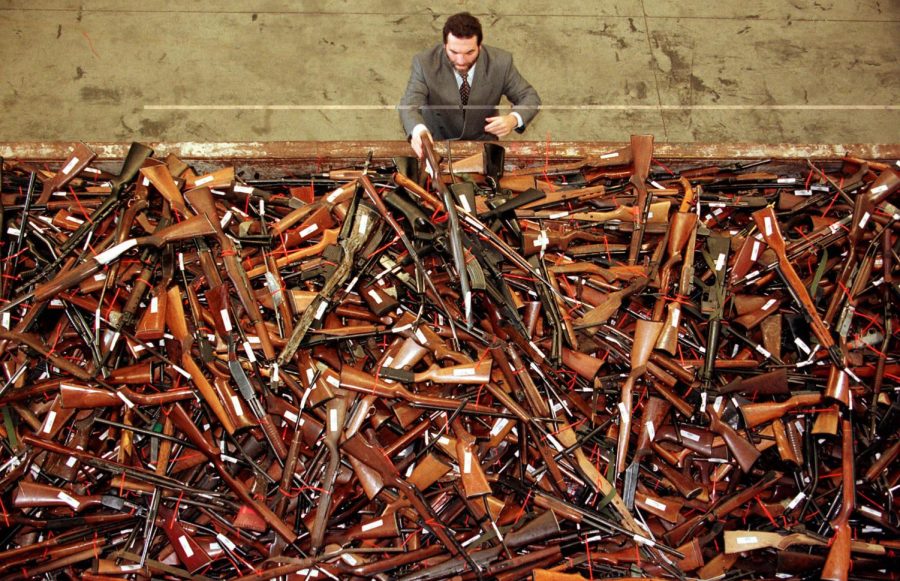Is it Time to Consider an Assault-Style Weapons Ban in America?
October 14, 2022
Twenty-six years ago, the calm seaside village of Port Arthur, Australia was shattered by the ringing of gunshots. Families out on a relaxing vacation fled in panic as a gunman walked into a café and began firing. By the end of the shooting spree, 35 people had been killed in the deadliest act of violence in recent Australian history. This horrific day was a tragedy for a country that had not seen mass violence of this kind since the colonial era, but it was also a wake-up call. The politically divided government, led by the conservative coalition of John Howard, responded almost immediately to the tragedy, and by the end of the year, the National Firearms Agreement was implemented across the whole country. The NFA, which to this day enjoys immense popularity among the Australian public, essentially banned the sale of automatic or semiautomatic weapons to civilians and created a licensing program for gun owners. This agreement came to define Australia’s approach to gun control for the next two and a half decades, during which time there has been only one mass shooting in the country. Scholars have debated the actual effectiveness of the NFA’s provisions for years, but the popularity of such a program in Australia begs the question: is it time to consider an assault-style weapons ban in the United States?
It is an unfortunate truth in the United States that we have become accustomed to devastating mass shootings. From Orlando to Las Vegas to, most recently, the school shooting in Uvalde, every year there seems to be a new tragedy in which dozens are killed. Each time, there is national outrage, fiery speeches, thoughts, and prayers, but each time we settle back into our routine and wait till the next inevitable shooting happens. Throughout the years, there have been a number of proposed solutions to this uniquely American problem. Red flag laws, mandatory waiting periods, and expanded background checks have all been proposed and supported by politicians on all sides of the political spectrum, and there have certainly been a number of successes in implementing measures like these. Most recently, Congress banned the sale of bump stocks following the shooting in Las Vegas. However, support has been growing recently for more “radical” propositions, such as an outright ban on the sale of assault-style semi-automatic weapons. This category would include the AR-15, the style of weapon which has been used in many mass shootings in recent years.
When such a proposal is brought up in the public sphere, the reaction from gun rights activists and others of strong conservative political persuasion is often dismissive. They claim such an idea is unconstitutional and a violation of the 2nd Amendment rights of American citizens to bear arms. While it is largely accepted these days that the Constitution guarantees the right to bear arms, the scope of this right is less clearly defined. For example, in the landmark 1939 Supreme Court case United State v. Miller, the Court argued that the defendant could not possess or sell a short-barreled shotgun, upholding Congress’ ability to limit the types of firearms which can be owned by civilians. In 1986, congress passed the Firearm Owners’ Protection Act, which banned the sale and transfer of assault rifles, or fully automatic weapons (This bill, curiously, was supported by the NRA, but we’ll get to that in a second). Then, in 1994, Congress passed a bill commonly known as the Federal Assault Weapons Ban. Due to the complicated nature in which the bill defined “assault weapon” and a lack of enforcement measures, the AWB had little effect. It did, however, survive multiple challenges in court, reaffirming Congress’ authority in regulating the sale of certain types of firearms. The AWB expired in 2004, and all attempts to revive it have failed.
The TLDR here is that the issue of an assault-style weapon ban is not a constitutional one, and never has been. The framing of it as such is a clever trick, but not necessarily a convincing one. Recent Gallup polls have found that around 55% of the American population supports an outright ban on the sale of assault-style weapons. While this number is relatively low when compared to support for other gun control measures such as expanded background checks (92%), 30-day waiting periods for gun purchases (77%), and raising the purchase age for firearms (76%), it still suggests that a majority of the American population supports measures to keep weapons like the AR-15 out of the hands of civilians.
So, if the issue is not a constitutional one, nor one of popularity, then why aren’t we taking proposals like this more seriously? Follow the money, stupid. It isn’t hard to see why so many members of Congress have portrayed an assault-style weapon ban as “radical” when they have received large sums of gun-lobby campaign donations. The most egregious offender in this scheme is the National Rifle Association, or NRA. As mentioned earlier, the NRA, at one time, supported Congressional gun control measures. However, the organization has grown increasingly hardline under the leadership of individuals like current CEO Wayne LaPierre, and today they donate millions of dollars to members of Congress who oppose gun control. I could devote an entire article to the moral deficiency of the NRA, but I will graciously spare you on this occasion. What I hope you all can take away from this, however, is that the issue of banning assault-style weapons, and indeed the issue of gun control as a whole, has never been about protecting people’s rights; it’s about cold, hard cash.
What I hope the reader can take away from all of this is a better understanding of the arguments surrounding the issue of banning assault-style weapons. This is an issue that, unfortunately, affects us every day as students in America, and as such it’s important to know what is being done about it. Although this is an opinion piece, I don’t want to tell you what to think, only that you should think deeply about what you want gun laws in this country to look like.

